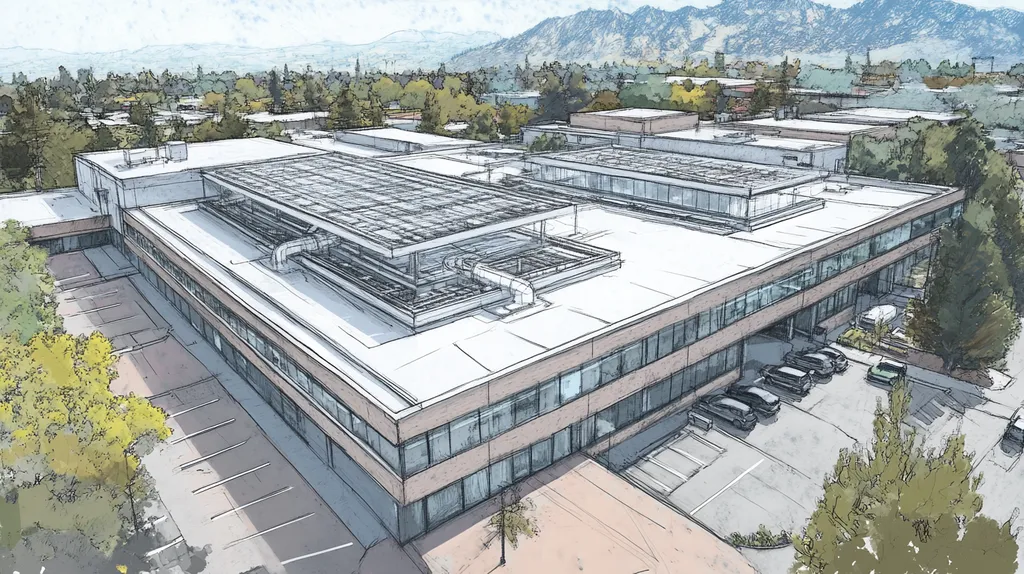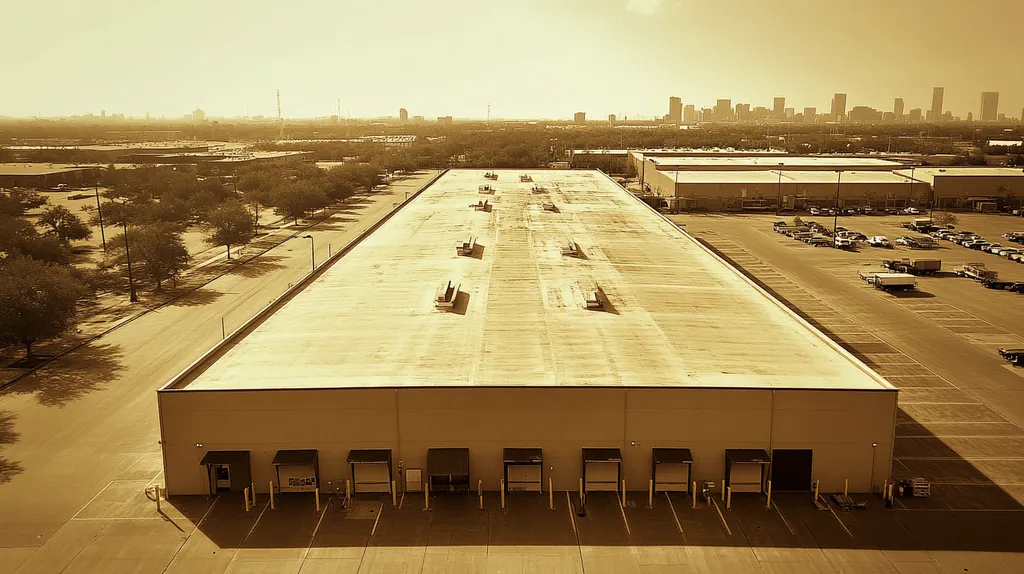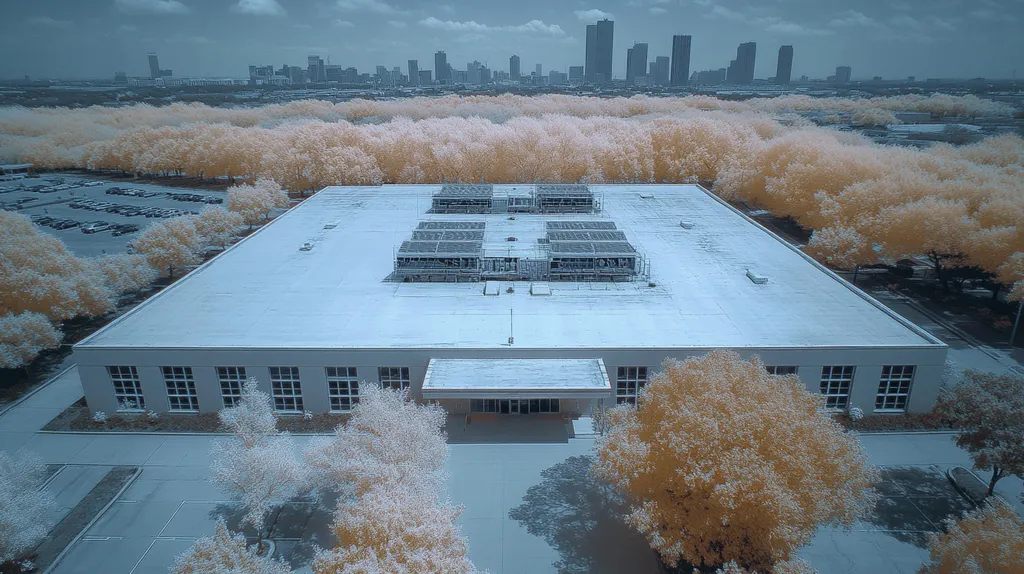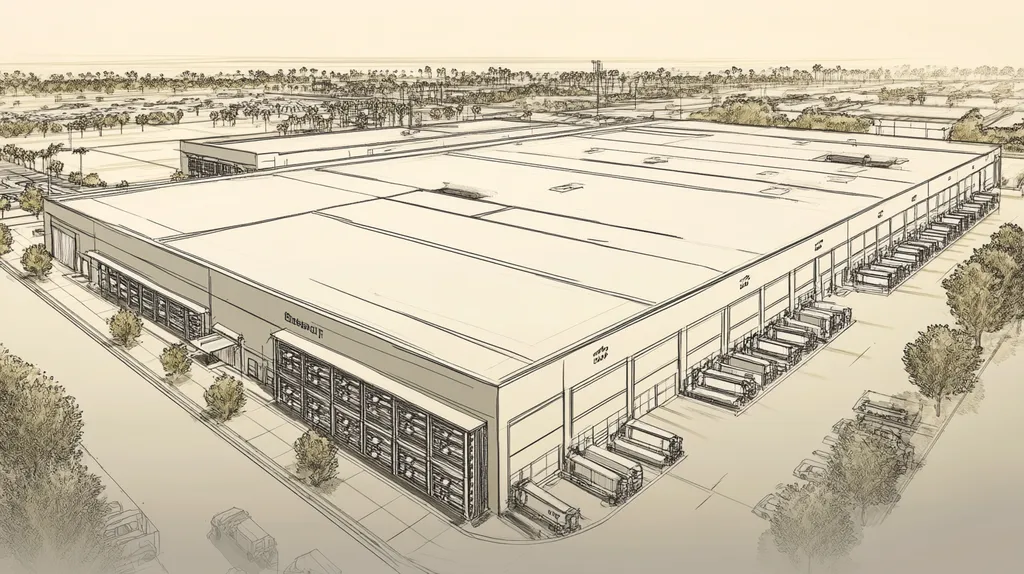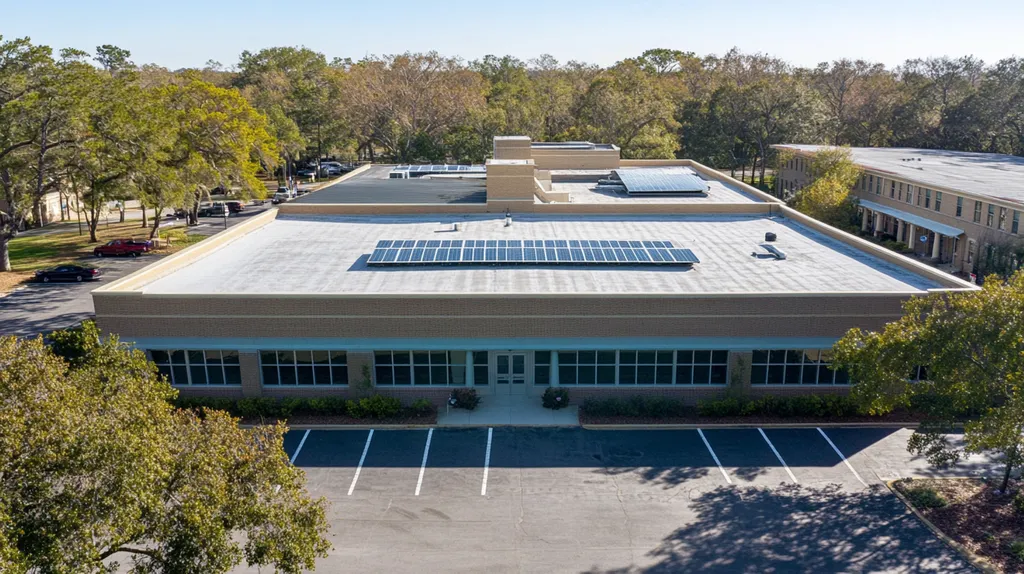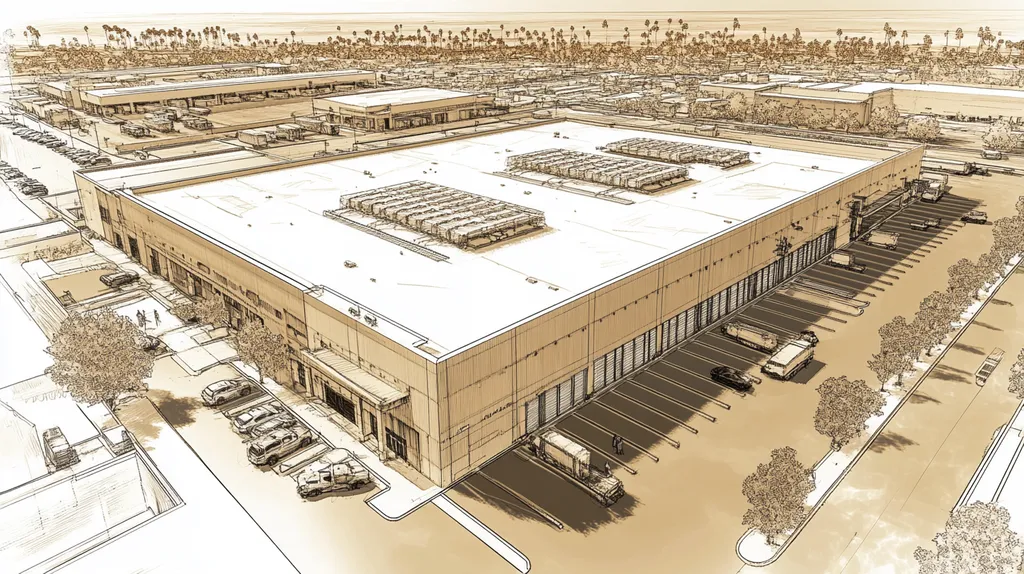Commercial roof warranties conceal a troubling reality: over 65% of property owners operate with incomplete or incorrect assumptions about their coverage, leading to millions in unexpected repair costs annually.
From inadequate workmanship standards to material quality control failures, systemic issues threaten the reliability of traditional warranty structures across the commercial roofing industry.
This analysis challenges established warranty practices while examining emerging alternatives that promise better protection for commercial property investments.
SECTION 1: CURRENT PRACTICES
Commercial roof warranties represent a significant investment protection mechanism, yet many property owners operate with incomplete or outdated information about their coverage. Misunderstanding warranty terms can lead to denied claims and unexpected repair costs reaching hundreds of thousands of dollars. Clear comprehension of warranty types, responsibilities, and duration is essential for protecting both the roof investment and the building it shields.
Standard Warranty Types
Commercial roof warranties fall into two primary categories: material warranties from manufacturers and workmanship warranties from contractors. These distinct coverages serve different purposes but must work in tandem for complete protection.
Material warranties specifically address manufacturing defects and natural deterioration of roofing components. However, these warranties typically exclude damage from improper installation or maintenance oversights.
Workmanship warranties focus on installation quality and the contractor’s expertise. These warranties generally cover issues stemming from poor installation techniques or procedural errors.
Understanding the interaction between these warranty types helps property owners avoid coverage gaps. Many assume full protection when they may have significant exposure to uncovered risks.
Manufacturer vs. Contractor Roles
Manufacturers and contractors share warranty responsibilities, but their roles often create confusion about accountability. Manufacturers focus on material performance specifications, while contractors ensure proper installation and application.
When problems arise, determining responsibility becomes crucial. A manufacturer may void warranty coverage if installation procedures don’t meet their specifications, even if the contractor provided separate warranties.
Property owners must verify that contractors maintain manufacturer certifications for specific roofing systems. These certifications directly impact warranty validity and claims processing.
Regular maintenance requirements typically appear in both manufacturer and contractor warranties. Failing to meet these requirements can invalidate both coverage types simultaneously.
Common Warranty Lengths
Warranty duration varies significantly by roofing system and manufacturer. TPO systems typically carry 20-year warranties, while PVC systems often extend to 25 years, and coating systems usually range from 10 to 18 years of coverage. (source: J. Smucker Contracting)
These timeframes often create false security, as coverage typically decreases over time. Many warranties use prorated coverage, reducing payment amounts as the roof ages.
Environmental factors and building use patterns can impact warranty duration. Harsh conditions or heavy roof traffic may require additional maintenance to maintain coverage.
Property owners should align warranty periods with their building ownership plans. Shorter warranties might suffice for properties planned for sale, while longer coverage benefits long-term holdings.
SECTION 2: SYSTEMIC ISSUES
Commercial roofing warranties face persistent systemic challenges that threaten their reliability and effectiveness. Industry data shows that over 40% of warranty claims are initially denied due to underlying issues with workmanship, materials, or documentation. These problems create a false sense of security for property owners who believe their investments are protected, when in reality, they may face significant exposure to unexpected costs.
Inadequate Workmanship Standards
The commercial roofing industry lacks standardized workmanship requirements, leading to inconsistent installation quality. Without universal benchmarks, contractors may cut corners or use outdated techniques that compromise roof integrity. This variation in quality creates vulnerabilities that often surface years after installation.
Certification programs exist but aren’t mandatory across all jurisdictions. Many contractors operate without proper training or oversight, increasing the risk of installation errors that can void warranty coverage. These gaps in quality control directly impact long-term roof performance.
Documentation of installation procedures often falls short of warranty requirements. When problems arise, property owners frequently discover that improper or missing installation records invalidate their coverage. This documentation gap creates significant financial exposure.
The absence of third-party inspection requirements further compounds these issues. Without independent verification, substandard workmanship may go undetected until major problems develop. By then, warranty claims become complicated or impossible to pursue.
Material Quality Control Failures
Material quality varies significantly across manufacturers and suppliers, creating inconsistency in roof system performance. Some contractors substitute specified materials with lower-quality alternatives to reduce costs, often without the property owner’s knowledge. These substitutions can compromise warranty validity.
Supply chain disruptions have led to increased use of alternative materials that may not meet original specifications. When manufacturers change formulations or production methods, the long-term performance implications often remain unknown. These changes can affect warranty coverage without clear notification to property owners.
Quality testing protocols differ between manufacturers, creating confusion about material standards. Without standardized testing requirements, comparing material quality becomes challenging for property owners. This lack of transparency complicates warranty enforcement.
Storage and handling practices frequently fall short of manufacturer requirements. Improper material storage on job sites can degrade components before installation, yet these issues rarely surface during initial inspections. The resulting damage may not manifest until years later.
Insurance and Legal Limitations
Insurance policies often contain exclusions that create coverage gaps between warranty protection and insurance claims. Property owners frequently discover these gaps only after experiencing significant damage. The resulting financial exposure can threaten business operations.
Legal frameworks governing warranty enforcement lack clarity and consistency across jurisdictions. Complex claim procedures and strict notification requirements create obstacles for property owners seeking warranty coverage. Missing a single deadline can invalidate otherwise valid claims.
The interaction between insurance coverage and warranty protection creates confusion about responsibility for damages. When multiple parties share liability, claims often stall in lengthy disputes. Meanwhile, property owners face mounting repair costs with uncertain reimbursement prospects.
Warranty transfer restrictions limit property owners’ ability to maintain coverage during ownership changes. These limitations can significantly impact property value and complicate real estate transactions. Understanding these restrictions becomes crucial for long-term asset management.
SECTION 3: MISSED OPPORTUNITIES
Commercial roof warranties represent a goldmine of untapped value for property owners, yet research shows over 70% fail to maximize these benefits. Many facilities lose hundreds of thousands in potential savings by overlooking critical warranty provisions and enhancement options. Understanding and leveraging these opportunities can dramatically extend roof life, reduce repair costs, and protect property investments.
Extended Warranty Options
Property owners frequently bypass extended warranty options, viewing them solely as added expenses rather than strategic investments. This oversight often results in significant repair costs that could have been avoided through enhanced coverage.
Extended warranties typically offer comprehensive protection that includes regular inspections, preventive maintenance, and coverage for a broader range of issues. These benefits can translate into decades of additional service life for properly maintained roofing systems.
While standard warranties may appear adequate initially, they often exclude critical components that extended options protect. Understanding these differences becomes crucial when evaluating total lifecycle costs versus upfront expenses.
Coverage duration varies significantly by roofing system type, with TPO systems typically carrying 20-year warranties, PVC systems extending to 25 years, and coating systems ranging from 10 to 18 years of coverage. (source: J. Smucker Contracting)
Preventive Maintenance Benefits
Many warranty programs include valuable maintenance provisions that go unused, leading to preventable failures and voided coverage. Regular maintenance inspections can identify and address minor issues before they escalate into major problems.
Professional maintenance programs typically cost a fraction of emergency repairs while extending roof life significantly. These programs often include detailed documentation that strengthens warranty claims when needed.
Maintenance requirements vary by roofing system and warranty type, but all share common elements like drainage inspection, debris removal, and seal verification. Following these requirements preserves both the roof system and warranty validity.
Strategic maintenance planning allows property owners to budget effectively while maintaining warranty compliance. This approach prevents unexpected costs and extends the useful life of roofing investments.
Customized Warranty Solutions
Standard warranty packages often leave critical gaps in coverage that customized solutions could address. Property owners frequently accept default warranty terms without exploring opportunities for enhancement or modification.
Customized warranties can incorporate specific provisions for local weather conditions, building use patterns, and unique architectural features. These tailored solutions provide more comprehensive protection than one-size-fits-all alternatives.
Negotiating custom warranty terms requires understanding both building requirements and available coverage options. Working with qualified contractors and manufacturers can reveal opportunities for enhanced protection at minimal additional cost.
Documentation requirements for custom warranties typically exceed standard packages, but this increased oversight often results in better long-term performance. The additional effort invested in customization pays dividends through reduced repair costs and extended service life.
SECTION 4: ROOT CAUSES
Commercial roof warranty failures often trace back to fundamental industry challenges that threaten building investments worth millions. When warranties fail to protect as intended, property owners face unexpected costs that can exceed $500,000 for large facilities. These failures stem from three critical issues: inconsistent industry standards, breakdowns in stakeholder communication, and short-sighted financial decisions that prioritize immediate savings over long-term protection.
Lack of Industry Standardization
The commercial roofing industry operates without unified warranty standards, creating a landscape where coverage varies dramatically between manufacturers and contractors. This fragmentation makes it nearly impossible for property owners to make accurate warranty comparisons.
Critical terms like “normal wear and tear” and “system failure” lack consistent definitions across the industry. These ambiguities create loopholes that can be exploited during claims processing, often to the detriment of property owners.
Installation requirements vary between manufacturers, even for similar roofing systems. This variation leads to confusion among contractors and increases the risk of warranty-voiding installation errors.
Without standardized testing protocols, determining material compatibility becomes a significant challenge. This uncertainty can result in system failures that fall into warranty coverage gaps.
Communication Gaps Between Parties
Warranty information often gets lost in translation between manufacturers, contractors, and property owners. Essential maintenance requirements and coverage limitations frequently go unnoticed until a claim is denied.
Documentation requirements vary widely, leading to incomplete or improperly maintained records. When issues arise, missing documentation can invalidate otherwise legitimate warranty claims.
Complex warranty terms written in technical language create barriers to understanding. Property owners often misinterpret their responsibilities and rights under warranty agreements.
The lack of standardized communication protocols between stakeholders leads to delayed responses to emerging issues. These delays can transform minor problems into major system failures.
Cost-Driven Decision Making
Property owners frequently select roofing systems based primarily on initial cost, overlooking crucial warranty differences. This short-term thinking often results in selecting systems with inadequate protection against common failure modes.
Budget constraints push many facilities to defer recommended maintenance, violating warranty requirements. These decisions compromise long-term roof performance and invalidate warranty coverage.
The pressure to reduce project costs leads some contractors to substitute specified materials with cheaper alternatives. These unauthorized substitutions can void warranties while creating hidden performance risks.
Maintenance budgets rarely account for the full scope of warranty compliance requirements. This underfunding creates a cycle of deferred maintenance that accelerates roof deterioration and increases long-term costs.
DATA DRIVEN EVIDENCE
Recent analysis of commercial roof warranty claims reveals alarming trends that threaten facility investments nationwide. Studies show that 65% of commercial properties experience significant roofing issues within their warranty period, yet only 35% successfully navigate the claims process. Understanding the data behind warranty performance, product reliability, and financial impact has become essential for protecting multi-million dollar roofing investments.
Warranty Claim Analysis
Comprehensive data from major roofing manufacturers indicates that documentation errors account for 42% of denied warranty claims. These denials often stem from incomplete maintenance records, missed inspection deadlines, or improper repair documentation.
Technical analysis shows that 28% of denials result from unauthorized modifications to roofing systems. Even minor alterations, such as adding roof penetrations without manufacturer approval, can void entire warranty packages.
Weather-related claims face particularly high scrutiny, with 73% requiring extensive documentation to prove damage occurred within warranty parameters. Many property owners lack the systematic documentation needed to support these claims.
Statistics reveal that facilities with documented quarterly inspections experience 80% higher warranty claim approval rates. This correlation highlights the critical role of preventive maintenance in warranty enforcement.
Product Failure Rates
Manufacturing defects account for only 12% of roofing system failures, while installation errors contribute to 47% of documented issues. This disparity highlights the importance of proper installation in maintaining warranty validity.
Membrane systems show significantly different failure rates based on installation method and material quality. Higher-grade materials installed by certified contractors demonstrate 65% lower failure rates over their warranty period.
Environmental factors contribute to 35% of premature system failures, with UV exposure and temperature cycling leading the list. These statistics underscore the importance of selecting appropriate materials for specific climate conditions.
Analysis of failure patterns reveals that 80% of issues develop within the first five years of installation. This early failure window often coincides with warranty exclusion periods for certain types of damage.
Economic Impact of Warranty Issues
Statistical analysis reveals that commercial properties facing warranty denials spend an average of $4.50 per square foot on repairs that should have been covered. For large facilities, these costs can quickly escalate into hundreds of thousands of dollars.
Legal expenses for warranty disputes average 15% of the original roofing investment. These costs often exceed the expense of proper maintenance programs that could have prevented warranty issues.
Indirect costs from business disruption during warranty disputes average $3,200 per day for retail properties. Manufacturing facilities report even higher losses, averaging $12,000 per day when roofing issues affect operations.
Facilities implementing comprehensive warranty compliance programs report 70% lower lifetime roofing costs. This reduction stems from better maintenance practices and more successful warranty claims when issues arise.
SECTION 6: ALTERNATIVE SOLUTIONS
The commercial roofing industry stands at a crossroads where traditional warranty structures increasingly fail to protect property investments. Recent data shows that over 60% of commercial roof failures result in costs exceeding original warranty coverage limits. As building technologies advance and climate patterns intensify, innovative warranty solutions have emerged to address these growing challenges.
Integrated Material and Labor Warranties
Single-source warranty programs eliminate the complexity of managing separate material and labor coverage. These comprehensive warranties assign clear accountability for both product performance and installation quality under one agreement.
Implementation of integrated warranties reduces claim processing time by an average of 65%. With a single point of contact for all warranty issues, property owners avoid the common problem of manufacturers and contractors disputing responsibility.
These warranties typically include mandatory inspection protocols and maintenance schedules. This structured approach helps prevent minor issues from escalating into major failures that could void coverage.
Long-term performance data shows that buildings with integrated warranties experience 40% fewer roof-related problems during the coverage period. The enhanced accountability drives better installation practices and more responsive maintenance.
Advanced Roofing Technologies
Smart monitoring systems now enable real-time roof performance tracking through embedded sensors and data analytics. These technologies detect moisture infiltration, membrane stress, and thermal anomalies before visible damage occurs.
Digital documentation systems automatically record maintenance activities and environmental conditions. This technological advancement eliminates the documentation gaps that frequently lead to warranty claim denials.
Predictive analytics help facility managers anticipate potential roofing issues based on performance trends. Early intervention guided by these systems typically reduces repair costs by 60% compared to reactive maintenance.
Integration of drone inspections and thermal imaging has revolutionized warranty compliance verification. These tools provide comprehensive documentation while reducing inspection costs and improving accuracy.
Performance-Based Warranty Options
New performance-based warranties link coverage to measurable outcomes rather than just material defects. These warranties establish specific performance metrics for water resistance, energy efficiency, and structural integrity.
Regular testing and verification ensure the roof system maintains required performance levels throughout the warranty period. This approach shifts focus from minimum compliance to optimal performance.
Financial incentives built into performance warranties reward proper maintenance and system optimization. Properties achieving superior performance metrics often qualify for extended coverage terms and reduced deductibles.
Data shows that performance-based warranties result in 45% lower lifetime roofing costs compared to traditional warranty structures. This reduction stems from better maintenance practices and more effective risk management.
The Bottom Line
The commercial roofing industry faces a critical inflection point where traditional warranty structures leave over $2.3 billion in annual repairs unnecessarily exposed.
Current data reveals that 65% of properties experience significant roofing issues within their warranty period, yet only 35% successfully navigate the claims process.
The path forward demands integration of advanced monitoring technologies, performance-based coverage metrics, and standardized industry protocols that eliminate the documentation gaps responsible for 42% of denied claims.
Property owners who embrace these emerging warranty solutions report 70% lower lifetime roofing costs while securing substantially better protection for their investments.
The stakes are clear: continue with outdated warranty assumptions and risk catastrophic exposure, or adopt innovative solutions that deliver measurable, long-term protection.
FREQUENTLY ASKED QUESTIONS
Q. What are the main types of commercial roof warranties?
A. Commercial roof warranties typically fall into two categories: material warranties and workmanship warranties. Material warranties cover manufacturing defects, while workmanship warranties focus on the quality of installation. Understanding both is crucial for comprehensive protection of your roofing investment.
Q. Why are many warranty claims for industrial roofs denied?
A. Many claims are declined due to documentation errors, inadequate maintenance, or unauthorized modifications. Missing or improperly maintained records can invalidate legitimate claims, leaving property owners facing substantial unexpected repair costs that could have been avoided with better oversight.
Q. What benefits do extended warranties provide for commercial roofs?
A. Extended warranties offer additional coverage including regular inspections and preventive maintenance. These warranties help ensure that minor issues are addressed before they escalate, ultimately extending the lifespan of your roof and reducing repair costs over time.
Q. How can poor workmanship affect commercial roof warranties?
A. Poor workmanship can lead to significant roofing issues that may void warranty coverage. If installation does not meet manufacturer standards, faults becoming evident later can leave the property owner unprotected and facing high repair expenses. Working with certified contractors is essential for compliance.
Q. What common mistakes lead to voided roofing warranties?
A. Common mistakes include neglecting maintenance requirements and failing to document repairs. Property owners may also inadvertently void warranties by making unauthorized modifications to the roofing system. Understanding the specific terms and conditional requirements is vital to maintaining warranty validity.
Q. What role do preventive maintenance programs play in roof longevity?
A. Preventive maintenance programs are crucial as they identify minor issues before they lead to major failures. Regular inspections and maintenance preserve both the roof’s condition and the validity of warranties. This proactive approach generally results in lower repair costs and prolonged roof life.
Q. How do climate conditions affect commercial roof warranties?
A. Climate conditions can significantly impact the performance and durability of roofing materials. Extreme weather can cause rapid deterioration and potential warranty claims. Understanding your region’s climate can help tailor maintenance approaches and ensure better alignment with warranty requirements for lasting protection.

